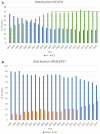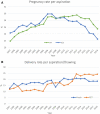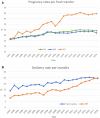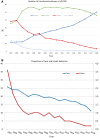ART in Europe, 2018: results generated from European registries by ESHRE
- PMID: 35795850
- PMCID: PMC9252765
- DOI: 10.1093/hropen/hoac022
ART in Europe, 2018: results generated from European registries by ESHRE
Abstract
Study question: What are the data and trends on ART and IUI cycle numbers and their outcomes, and on fertility preservation (FP) interventions, reported in 2018 as compared to previous years?
Summary answer: The 22nd ESHRE report shows a continued increase in reported numbers of ART treatment cycles and children born in Europe, a decrease in transfers with more than one embryo with a further reduction of twin delivery rates (DRs) as compared to 2017, higher DRs per transfer after fresh IVF or ICSI cycles (without considering freeze-all cycles) than after frozen embryo transfer (FET) with higher pregnancy rates (PRs) after FET and the number of reported IUI cycles decreased while their PR and DR remained stable.
What is known already: ART aggregated data generated by national registries, clinics or professional societies have been gathered and analysed by the European IVF-monitoring Consortium (EIM) since 1997 and reported in 21 manuscripts published in Human Reproduction and Human Reproduction Open.
Study design size duration: Data on medically assisted reproduction (MAR) from European countries are collected by EIM for ESHRE on a yearly basis. The data on treatment cycles performed between 1 January and 31 December 2018 were provided by either national registries or registries based on initiatives of medical associations and scientific organizations or committed persons of 39 countries.
Participants/materials setting methods: Overall, 1422 clinics offering ART services in 39 countries reported a total of more than 1 million (1 007 598) treatment cycles for the first time, including 162 837 with IVF, 400 375 with ICSI, 309 475 with FET, 48 294 with preimplantation genetic testing, 80 641 with egg donation (ED), 532 with IVM of oocytes and 5444 cycles with frozen oocyte replacement (FOR). A total of 1271 institutions reported data on IUI cycles using either husband/partner's semen (IUI-H; n = 148 143) or donor semen (IUI-D; n = 50 609) in 31 countries and 25 countries, respectively. Sixteen countries reported 20 994 interventions in pre- and post-pubertal patients for FP including oocyte, ovarian tissue, semen and testicular tissue banking.
Main results and the role of chance: In 21 countries (21 in 2017) in which all ART clinics reported to the registry, 410 190 treatment cycles were registered for a total population of ∼ 300 million inhabitants, allowing a best estimate of a mean of 1433 cycles performed per million inhabitants (range: 641-3549). Among the 39 reporting countries, for IVF, the clinical PR per aspiration slightly decreased while the PR per transfer remained similar compared to 2017 (25.5% and 34.1% in 2018 versus 26.8% and 34.3% in 2017). In ICSI, the corresponding rates showed similar evolutions in 2018 compared to 2017 (22.5% and 32.1% in 2018 versus 24.0% and 33.5% in 2017). When freeze-all cycles were not considered for the calculations, the clinical PRs per aspiration were 28.8% (29.4% in 2017) and 27.3% (27.3% in 2017) for IVF and ICSI, respectively. After FET with embryos originating from own eggs, the PR per thawing was 33.4% (versus 30.2% in 2017), and with embryos originating from donated eggs 41.8% (41.1% in 2017). After ED, the PR per fresh embryo transfer was 49.6% (49.2% in 2017) and per FOR 44.9% (43.3% in 2017). In IVF and ICSI together, the trend towards the transfer of fewer embryos continues with the transfer of 1, 2, 3 and ≥4 embryos in 50.7%, 45.1%, 3.9% and 0.3% of all treatments, respectively (corresponding to 46.0%, 49.2%. 4.5% and 0.3% in 2017). This resulted in a reduced proportion of twin DRs of 12.4% (14.2% in 2017) and similar triplet DR of 0.2%. Treatments with FET in 2018 resulted in twin and triplet DRs of 9.4% and 0.1%, respectively (versus 11.2% and 0.2%, respectively in 2017). After IUI, the DRs remained similar at 8.8% after IUI-H (8.7% in 2017) and at 12.6% after IUI-D (12.4% in 2017). Twin and triplet DRs after IUI-H were 8.4% and 0.3%, respectively (in 2017: 8.1% and 0.3%), and 6.4% and 0.2% after IUI-D (in 2017: 6.9% and 0.2%). Among 20 994 FP interventions in 16 countries (18 888 in 13 countries in 2017), cryopreservation of ejaculated sperm (n = 10 503, versus 11 112 in 2017) and of oocytes (n = 9123 versus 6588 in 2017) were the most frequently reported.
Limitations reasons for caution: The results should be interpreted with caution as data collection systems and completeness of reporting vary among European countries. Some countries were unable to deliver data about the number of initiated cycles and/or deliveries.
Wider implications of the findings: The 22nd ESHRE data collection on ART, IUI and FP interventions shows a continuous increase of reported treatment numbers and MAR-derived livebirths in Europe. Although it is the largest data collection on MAR in Europe, further efforts towards optimization of both the collection and reporting, with the aim of improving surveillance and vigilance in the field of reproductive medicine, are awaited.
Study funding/competing interests: The study has received no external funding and all costs are covered by ESHRE. There are no competing interests.
Keywords: ICSI; IUI; IVF; data collection; egg donation; fertility preservation; frozen embryo transfer; registry; surveillance; vigilance.
© The Author(s) 2022. Published by Oxford University Press on behalf of European Society of Human Reproduction and Embryology.
Figures





References
-
- Braat DDM, Schutte JM, Bernardus RE, Mooij TM, van Leeuwen FE.. Maternal death related to IVF in the Netherlands 1984–2008. Hum Reprod 2010;25:1782–1786. - PubMed
-
- Calhaz-Jorge C, De Geyter CH, Kupka MS, Wyns C, Mocanu E, Motrenko T, Scaravelli G, Smeenk J, Vidakovic S, Goossens V.. Survey on ART and IUI: legislation, regulation, funding and registries in European countries: the European IVF-monitoring Consortium (EIM) for the European Society of Human Reproduction and Embryology (ESHRE). Hum Reprod Open 2020;2020:hoz044. - PMC - PubMed
-
- Chambers GM, Dyer S, Zeger-Hochschild F, de Mouzon J, Ishihara O, Banker M, Mansour R, Kupka MS, Adamson GD.. International Committee for Monitoring Assisted Reproductive Technologies world report: assisted reproductive technology, 2014. Hum Reprod 2021;36:2921–2934. - PubMed
-
- De Geyter C, Calhaz-Jorge C, Kupka MS, Wyns C, Mocanu E, Motrenko T, Scaravelli G, Smeenk J, Vidakovic S, Goossens V;. European IVF-monitoring Consortium (EIM) for the European Society of Human Reproduction and Embryology (ESHRE). ART in Europe, 2015: results generated from European registries by ESHRE. Hum Reprod Open 2020a;2020:hoz038. - PMC - PubMed
LinkOut - more resources
Full Text Sources
Other Literature Sources
Research Materials
